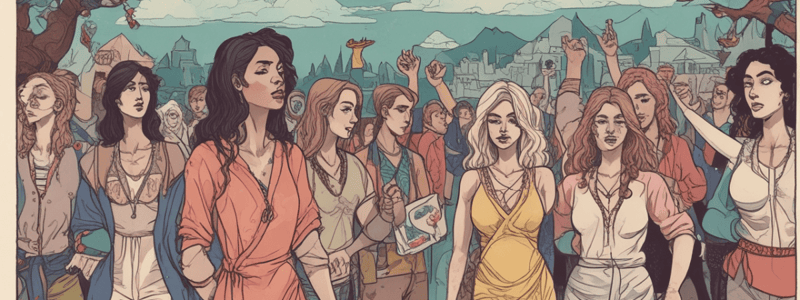Podcast
Questions and Answers
What is the primary characteristic of a patriarchal system?
What is the primary characteristic of a patriarchal system?
- There is no dominance between men and women
- Men and women share equal power and dominance
- Men hold more power and dominance than women (correct)
- Women hold more power and dominance than men
What is a result of patriarchal systems?
What is a result of patriarchal systems?
- Gender equality and justice
- Gender inequality and discrimination (correct)
- No impact on society
- Limited opportunities for men
What is a common feature of patriarchal societies?
What is a common feature of patriarchal societies?
- No gender roles
- Egalitarian gender roles
- Matriarchal systems
- Traditional gender roles with men as breadwinners and women as caregivers (correct)
What is a consequence of patriarchal attitudes and structures?
What is a consequence of patriarchal attitudes and structures?
In which ancient civilizations did patriarchal systems have roots?
In which ancient civilizations did patriarchal systems have roots?
What has been criticized for perpetuating gender inequality and limiting women's rights?
What has been criticized for perpetuating gender inequality and limiting women's rights?
What is a challenge to patriarchal systems?
What is a challenge to patriarchal systems?
What is linked to patriarchy?
What is linked to patriarchy?
Study Notes
Definition and Overview
- Patriarchy refers to a societal system in which men hold more power and dominance than women, often resulting in gender inequality and discrimination.
- It is a system of social organization where men are seen as superior and women are seen as subordinate.
Key Features
- Gender-based hierarchy: Men are considered superior and hold more power, while women are seen as inferior and subordinate.
- Male dominance: Men hold more power and control over resources, institutions, and decision-making processes.
- Gender roles: Traditional gender roles are reinforced, with men expected to be breadwinners and women expected to be caregivers.
Effects of Patriarchy
- Gender inequality: Women are often denied equal rights, opportunities, and access to resources, leading to systemic inequality.
- Gender-based violence: Patriarchy can contribute to a culture of violence against women, including domestic violence, sexual assault, and harassment.
- Limited opportunities: Women may face barriers to education, employment, and political participation due to patriarchal attitudes and structures.
Historical and Cultural Context
- Patriarchy has been present in many societies throughout history, with roots in ancient civilizations such as Greece and Rome.
- Patriarchal systems have been reinforced and perpetuated through religion, law, and social norms.
- Different cultures and societies have their own unique forms of patriarchy, shaped by historical, economic, and political factors.
Challenges and Critiques
- Patriarchy has been criticized for perpetuating gender inequality and limiting the rights and opportunities of women.
- Feminist movements and critiques have challenged patriarchal systems and structures, calling for greater gender equality and justice.
- Patriarchy has also been linked to other forms of oppression, such as racism, classism, and homophobia.
Intersectionality and Patriarchy
- Patriarchy intersects with other forms of oppression, such as race, class, and sexuality, to create unique experiences of discrimination and marginalization.
- Women of color, LGBTQ+ individuals, and women from lower socioeconomic backgrounds may face multiple forms of oppression, including patriarchy.
Definition and Overview
- Patriarchy is a societal system where men hold more power and dominance than women, resulting in gender inequality and discrimination.
- It is a system of social organization where men are seen as superior and women are seen as subordinate.
Key Features
- Patriarchy is characterized by a gender-based hierarchy where men are considered superior and women are seen as inferior.
- Men hold more power and control over resources, institutions, and decision-making processes, leading to male dominance.
- Traditional gender roles are reinforced, with men expected to be breadwinners and women expected to be caregivers.
Effects of Patriarchy
- Patriarchy leads to gender inequality, denying women equal rights, opportunities, and access to resources.
- It contributes to a culture of violence against women, including domestic violence, sexual assault, and harassment.
- Women face barriers to education, employment, and political participation due to patriarchal attitudes and structures.
Historical and Cultural Context
- Patriarchy has been present in many societies throughout history, with roots in ancient civilizations such as Greece and Rome.
- Patriarchal systems have been reinforced and perpetuated through religion, law, and social norms.
- Different cultures and societies have unique forms of patriarchy, shaped by historical, economic, and political factors.
Challenges and Critiques
- Patriarchy has been criticized for perpetuating gender inequality and limiting the rights and opportunities of women.
- Feminist movements and critiques have challenged patriarchal systems and structures, calling for greater gender equality and justice.
- Patriarchy has also been linked to other forms of oppression, such as racism, classism, and homophobia.
Intersectionality and Patriarchy
- Patriarchy intersects with other forms of oppression, such as race, class, and sexuality, to create unique experiences of discrimination and marginalization.
- Women of color, LGBTQ+ individuals, and women from lower socioeconomic backgrounds face multiple forms of oppression, including patriarchy.
Studying That Suits You
Use AI to generate personalized quizzes and flashcards to suit your learning preferences.
Description
Learn about the societal system where men hold more power and dominance than women, resulting in gender inequality and discrimination. Understand the key features of patriarchy, including gender-based hierarchy and male dominance.





